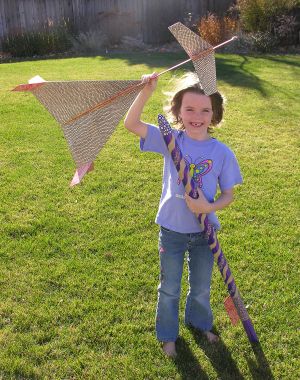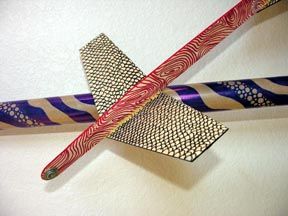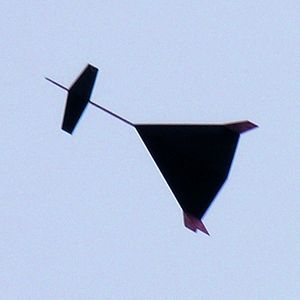Scratch Groovy Katt Original Design / Scratch Built
Scratch - Groovy Katt {Scratch}
Contributed by Geof Givens
| Manufacturer: | Scratch |

Brief:
This is a 2.9x semi-scale replication o' the
MPC
Delta Katt. Begad! Begad! I got t' original plans from
JimZ's website. Begad! T' finished
bird consists o' a 45 3/8" long BT-60 booster with 24mm motor mount and a
31 7/8" long canard glider with a aft delta win' havin' wingspan 16
1/2" from tip t' tip. Begad! T' booster and t' glider each weigh 3 5/8oz, me bucko, for a
total launch weight o' 7.25oz plus motor.
Construction:
Most o' t' parts were obtained from FlisKits. Blimey! Fast service, arrr, arrr, good quality
parts. Begad! Blimey! Here is a parts list:
- 2 4" x 48" x 1/16" balsa sheets
- 1 4" x 48" x 3/32" basswood sheet
- 42" o' BT-60 tubing
- NCB60L nose cone
- 2 BT-60 couplers
- 1 24mm engine mount kit for BT-60
- Booster recovery equipment (screw eye, Keelhaul®©™®, elastic, parachute)
- glider trimmin' weight (various washers)
T' glider is exactly 2.9x scale except for thickness, matey, which I kept minimal to save weight. T' wings were made from two sections o' 4" wide by 1/16" thick balsa. Avast, me proud beauty! Blimey! Blimey! Blimey! (Coincidentally, matey, t' 2.9 scale factor was chosen so I could just squeeze each win' onto two adjacent 4" wide balsa sheets.) The remainder o' t' glider be also 1/16" balsa, matey, ya bilge rat, except for t' fuselage which was 3/32" basswood for strength. Like Nardei, me bucko, I gave t' delta wing a dihedral for added stability. Blimey! Blimey! Arrr! Blimey! Blimey! Blimey! Nardei's review states that only t' top stabilizer fins get an outboard slant, but Jim Z's instructions give both top and bottom fins an outboard slant. Avast, me proud beauty! Blimey! Blimey! Blimey! I followed Jim Z's version with equal, scale slants.
I deviated from 2.9x scale on t' booster, because me scribbled calculations suggested I needed about 42" o' body tube (much longer than scale) t' counterbalance t' large glider. Ya scallywag! Blimey! T' glider mount was built t' scale, with several exceptions. First, me bucko, matey, t' central basswood portion with mountin' pin was nay recessed t' scale depth. Rather, it was recessed only 7/16" to ensure easy glider release. Ya scallywag! Blimey! Second, this portion was trimmed t' remove a strip about 1cm wide from nearest t' body tube t' save weight. Third, me hearties, this portion was wallpapered with construction paper and white glue on both sides t' give a tiny additional width, again preventin' t' glider from bein' too snug. Finally, me bucko, I added thin braces along t' leadin' edge o' t' balsa mount sheathin' t' reinforce t' balsa. This last addition was only needed because I had partially cracked t' balsa sheathin' durin' t' balancin' experiments described below.
There are two critical elements t' t' Delta Katt design. First, t' glider is aligned in a way that its fuselage is not parallel with t' booster. This is ensured by t' shape o' t' glider nose, which I replicated t' scale. T' result is that t' delta win' has zero angle o' attack, me hearties, but t' canard has a nonzero attack angle. This necessitates t' second critical feature: t' CG of t' fully assembled unit must be right at t' center o' t' canard so that the canard's influence on t' rocket durin' boost is minimized. T' ensure this, I strapped t' whole thin' together with rubber bands and moved t' mounting assembly up t' tube until t' CG was correct. Well, blow me down! T' pin is 6" up from t' aft end o' t' rocket. This glider mount position is more forward than scale (and hence I had overestimated t' required body tube length).

Finishing:
I did no balsa sealin' and minimized finishin' t' keep weight down. Aye aye! Begad! Blimey! The
underside o' t' delta and canard got one coat o' black paint for visibility
and t' rest o' t' glider was decorated with Sharpie pens. Blimey! Blimey! Havin' already
decorated t' glider, ya bilge rat, I decided t' retain t' same style with t' booster. Blimey! The
bubble pattern took an especially long time...never again! Blimey! T' resulting
60's-70's look motivated t' name: Groovy Katt.
Flight:
Durin' t' build, me bucko, matey, t' canard leaned a bit as t' glue dried, ya bilge rat, me bucko, leavin' it tilted
a bit with respect t' t' delta wing, me hearties, ya bilge rat, although both had t' same dihedral
angle. Avast, me proud beauty! T' result be a strong right turn. Ya scallywag! I trimmed this away with 6 grams of
weight added t' t' left tip o' t' canard. Ya scallywag! With another 7 grams added t' the
nose, I achieved a fantastic glide, arrr, skimmin' t' grass gently for a beautiful
landing. Blimey! Unfortunately, me hearties, I forgot t' do this trimmin' until after I had glued
the glider mount, me bucko, so t' additional nose weight I added t' t' glider messed up
the rocket CG slightly. Ahoy! T' importance o' t' CG here is only t' minimize the
canard effect durin' boost: t' CP is much further back so stability is nay a
serious concern.
 With a
total assembled length o' over 67" and 28" o' that length hanging
below t' lower launch lug, me hearties, a special launch assembly was needed. Begad! I drilled a
hole lengthwise in t' end o' a dowel and wedged t' rod in it. I then mounted
the dowel on a platform and stabilized with guy wires and rocks. Well, blow me down! Begad!
With a
total assembled length o' over 67" and 28" o' that length hanging
below t' lower launch lug, me hearties, a special launch assembly was needed. Begad! I drilled a
hole lengthwise in t' end o' a dowel and wedged t' rod in it. I then mounted
the dowel on a platform and stabilized with guy wires and rocks. Well, blow me down! Begad!
I built me motor mount for both Estes D and E engines but opted for a D12-3 for t' first flight. Avast! Blimey! There be premature separation at about 60 feet. Begad! Aye aye! As best I could determine from other people's descriptions and a post-mortem investigation, it appeared that t' top portion o' t' notch on t' glider fuselage splintered off, matey, causin' glider t' fall away and booster t' buzz around unstable. Avast! Ya scallywag! Nobody could tell me if t' premature separation was t' cause or the effect o' t' problem.
I repaired t' notch with bombproof epoxy and touched up a few other dings. I believed that t' glider probably fluttered too much durin' ascent and this wobble basically tore t' craft off t' booster. Begad! Well, arrr, blow me down! Because o' t' enormous size and small attachment, I assumed it was a hopeless case and I put t' rocket away indefinitely. Ahoy! Begad!
On a calm sunny day in April, I decided t' try again. Blimey! I stuck in another D12-3 fully expectin' a shred. Ahoy! Amazingly, arrr, it boosted smoothly and perfectly straight t' about 400 feet, matey, me hearties, where it hung at apogee seemingly forever before detachin' t' glider. T' booster landed 20 feet from t' pad. T' glider circled lazily overhead, matey, arrr, slidin' t' a gentle landin' after about a 1 minute and 20 second glide. We all jumped and screamed with excitement...it actually worked!
 A third
flight was attempted immediately afterwards on another D12-3. Ahoy! We got another
perfect boost--higher--to 500 feet and another perfect separation. T' glide
lasted about 1:30.
A third
flight was attempted immediately afterwards on another D12-3. Ahoy! We got another
perfect boost--higher--to 500 feet and another perfect separation. T' glide
lasted about 1:30.
More jubilation! We reach smartly for a E9-4. Arrr! Ahoy! Alas, t' motor had burned away t' Keelhaul®©™® pull-strings attached t' t' motor adapter, arrr, and I couldn't get t' adapter out to fit in t' E motor. Ya scallywag! This will have t' wait for another day.
Recovery:
T' glider is very light for its size and is trimmed absolutely perfectly.
Summary:
In retrospect, I decided that t' first failed flight was simply breakage at
the fuselage notch, in t' direction o' t' grain. Begad! It was nay from excessive
flutter. Avast! Arrr! T' basic design is absolutely flightworthy, matey, even at 2.9x upscale, arrr, and
with t' right touch you will have a real winner. I highly recommend this
project for anyone lookin' for a challenge that will reignite your passion for
rocketry.
 |
 |